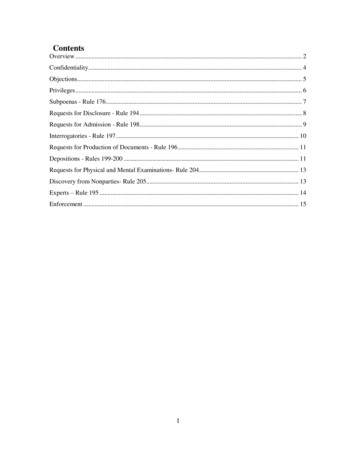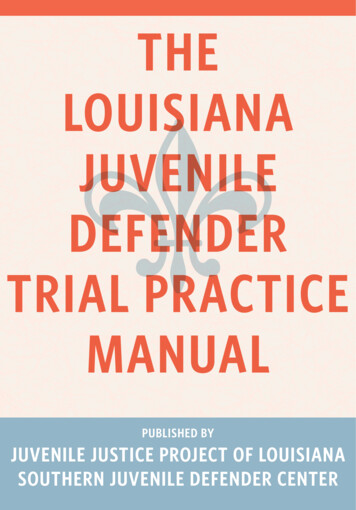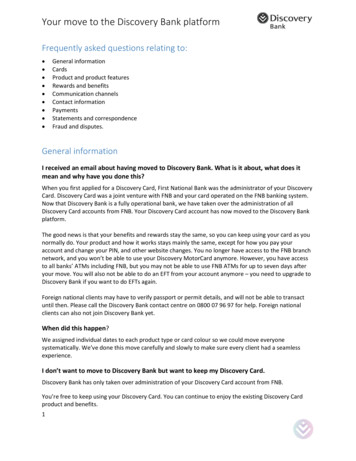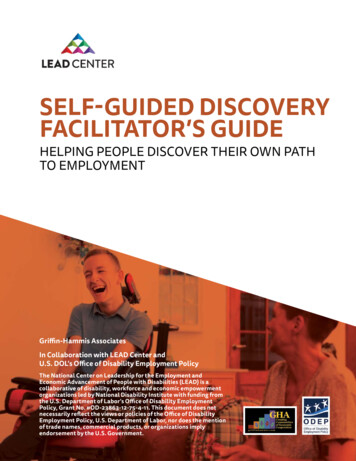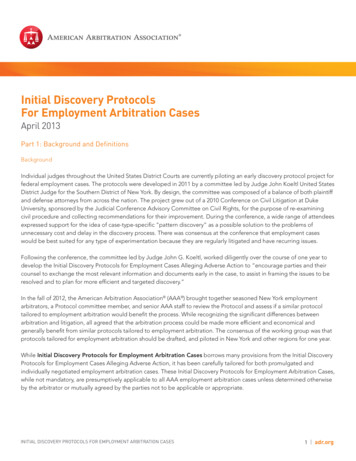
Transcription
Initial Discovery ProtocolsFor Employment Arbitration CasesApril 2013Part 1: Background and DefinitionsBackgroundIndividual judges throughout the United States District Courts are currently piloting an early discovery protocol project forfederal employment cases. The protocols were developed in 2011 by a committee led by Judge John Koeltl United StatesDistrict Judge for the Southern District of New York. By design, the committee was composed of a balance of both plaintiffand defense attorneys from across the nation. The project grew out of a 2010 Conference on Civil Litigation at DukeUniversity, sponsored by the Judicial Conference Advisory Committee on Civil Rights, for the purpose of re-examiningcivil procedure and collecting recommendations for their improvement. During the conference, a wide range of attendeesexpressed support for the idea of case-type-specific “pattern discovery” as a possible solution to the problems ofunnecessary cost and delay in the discovery process. There was consensus at the conference that employment caseswould be best suited for any type of experimentation because they are regularly litigated and have recurring issues.Following the conference, the committee led by Judge John G. Koeltl, worked diligently over the course of one year todevelop the Initial Discovery Protocols for Employment Cases Alleging Adverse Action to “encourage parties and theircounsel to exchange the most relevant information and documents early in the case, to assist in framing the issues to beresolved and to plan for more efficient and targeted discovery.”In the fall of 2012, the American Arbitration Association (AAA ) brought together seasoned New York employmentarbitrators, a Protocol committee member, and senior AAA staff to review the Protocol and assess if a similar protocoltailored to employment arbitration would benefit the process. While recognizing the significant differences betweenarbitration and litigation, all agreed that the arbitration process could be made more efficient and economical andgenerally benefit from similar protocols tailored to employment arbitration. The consensus of the working group was thatprotocols tailored for employment arbitration should be drafted, and piloted in New York and other regions for one year.While Initial Discovery Protocols for Employment Arbitration Cases borrows many provisions from the Initial DiscoveryProtocols for Employment Cases Alleging Adverse Action, it has been carefully tailored for both promulgated andindividually negotiated employment arbitration cases. These Initial Discovery Protocols for Employment Arbitration Cases,while not mandatory, are presumptively applicable to all AAA employment arbitration cases unless determined otherwiseby the arbitrator or mutually agreed by the parties not to be applicable or appropriate.INITIAL DISCOVERY PROTOCOLS FOR EMPLOYMENT ARBITRATION CASES1 adr.org
DefinitionsThe following definitions apply to cases proceeding under the Initial Discovery Protocols for Employment Arbitration Cases.a. Concerning. The term “concerning’’ means referring to, describing, evidencing, or constituting.b. Document. The term “document” includes writings, drawings, graphs, charts, photographs, sound recordings,images, and other data. The term “document” also includes electronically stored information in any medium,including emails, text messages and similarly stored information that can be obtained either directly or, ifnecessary, after translation by the responding party into a reasonably usable form.c. Identify (Documents). When referring to documents, to “identify’’ means to give, to the extent known: (i) the typeof document; (ii) the general subject matter of the document; (iii) the date of the document ; (iv) the author(s),according to the document; and (v) the person(s) to whom, according to the document, the document (or acopy) was sent [?]; or, alternatively, to produce the document.d. Identify (Persons). When referring to natural persons, to “identify’’ means to give the person’s: (i) full name;(ii) present or last known address and telephone number; (iii) present or last known place of employment;(iv) present or last known job title; and, (v) relationship, if any, to the claimant or respondent. Once a personhas been identified in accordance with this subparagraph, only the name of that person need be listed insubsequent discovery requesting the identification of that person.e. Initial Discovery. Initial Discovery comprises the documents and information specified below in Part 2(for claimant) and Part 3 (for respondent).Instructionsa. For this Initial Discovery, the time period being no more than three years before the date of the matter(s) incontroversy, unless otherwise specified.b. This Initial Discovery is not subject to objections except with respect to (i) claims of privilege and (ii) specificlimitations based on electronically stored information from sources that the party identifies as not reasonablyaccessible because of undue burden or cost. On a motion to compel discovery or for a protective order, theparty from whom discovery is sought must show that the information is not reasonably accessible because ofundue burden or cost. If that showing is made, the arbitrator may nonetheless order discovery from suchsources if the requesting party shows good cause. The arbitrator may specify conditions for the discovery.c. A party or counsel is required to certify, by signature, that the discovery provided is complete and correct atthe time it is produced. If a partial or incomplete answer or production is provided, the responding party shallstate the reason that the answer or production is considered partial or incomplete.d. Documents must be produced as kept in the normal course of business, and must be organized and labeledto correspond to the numbers of the requests. Electronically stored information must be produced in a formin which it is ordinarily maintained or in a reasonably usable form and must be organized and labeled tocorrespond to the numbers of the requests.INITIAL DISCOVERY PROTOCOLS FOR EMPLOYMENT ARBITRATION CASES2 adr.org
Part 2: Production by Claimant(1) Timinga. The claimant’s Initial Discovery shall be provided within 30 days after the respondent has submitted aresponsive pleading or motion, unless the arbitrator rules otherwise.(2) Documents that Claimant must produce to Respondenta. All communications concerning the factual allegations or claims at issue in the arbitration between theclaimant and the respondent.b. Claims, lawsuits, administrative charges, and complaints by the claimant that rely upon any of the same factualallegations or claims as those at issue in the arbitration.c. Documents concerning the formation and termination, if any, of the employment relationship to the extenteither is relevant to the claims or issues in the arbitration, irrespective of the relevant time period.d. Documents concerning [the terms and conditions] of the employment relationship, to the extent relevant andmaterial with respect to the claims or issues in the arbitration.e. Diary, Journal, and calendar entries, whether written or electronic, maintained by the claimant concerning thefactual allegations or claims at issue in the arbitration.f. The claimant’s current resume(s).g. Documents in the possession of the claimant concerning any application or claim for unemployment benefits,[unless production is prohibited by applicable law].h. If mitigation of damages is an issue in the case, documents concerning: (i) communications with potentialemployers; (ii) job search efforts; (iii) offer(s) of employment, job description(s), and income and benefits ofsubsequent employment, and (iv) the termination of any subsequent employment. The respondent shall notcontact or subpoena a prospective or current employer to discover information about the claimant’s claimswithout first providing the claimant 30 days’ notice and an opportunity to file a motion for a protective orderor a motion to quash such subpoena. If such a motion is filed, contact will not be initiated or the subpoena willnot be served until the motion is ruled upon.i.Any other document(s) upon which the claimant relies to support the claimant’s claims.(3) Information that Claimant must produce to Respondenta. Identify persons the claimant believes to have knowledge of the facts concerning the claims or defenses atissue in the arbitration, and brief description of that knowledge.b. Describe the categories of damages the claimant claims and the amounts of damages with respect to eachcategory to the extent feasible.INITIAL DISCOVERY PROTOCOLS FOR EMPLOYMENT ARBITRATION CASES3 adr.org
c. State whether the claimant has applied for disability benefits and/or social security disability benefits after theadverse action, whether any application has been granted, and the nature of the award, if any. Identify anydocument concerning any such application.Part 3: Production by Respondent(1) Timinga. The respondent’s Initial Discovery shall be provided within 30 days after the respondent has submitted aresponsive pleading or motion, unless the arbitrator rules otherwise.(2) Documents that Respondent must produce to Claimant [See comments to prior section about terminology]a. All documents concerning the factual allegations or claims at issue in the arbitration among or between:i.The claimant and the respondent;ii. The claimant’s manager(s) and/or supervisor(s), the respondent’s human resources representative(s) andany other decision maker.iii. Respondent and any non-party (except to the extent a privilege applies).b. Responses to claims, lawsuits, administrative charges, and complaints by the claimant that rely upon any of thesame factual allegations or claims as those at issue in the arbitration.c. Documents concerning the formation and termination, if any, of the employment relationship to the extenteither is relevant to the claims or issues in the arbitration, irrespective of the relevant time period.d. The claimant’s personnel file, in any form maintained by the respondent, including files concerning theclaimant maintained by the claimant’s supervisor(s) and/or manager(s), respondent’s human resourcesrepresentative(s) and any other decision maker, irrespective of the relevant time period. If not included in thepersonnel file, the claimant’s performance evaluations and formal discipline reports or write-ups.e. Documents relied upon to make the employment decision(s) at issue in the arbitration.f. Workplace policies or guidelines relevant to the claimant’s claims or respondent’s defenses and/orcounterclaims in effect at the time of the adverse action, including policies or guidelines that address:i.Discipline;ii. Termination of employment;iii. Promotion;iv. Discrimination;v. Performance reviews or evaluations;vi. Misconduct;vii. Retaliation; andINITIAL DISCOVERY PROTOCOLS FOR EMPLOYMENT ARBITRATION CASES4 adr.org
viii.Nature of the employment relationship.g. The table of contents and index of any employee handbook, code of conduct, or policies and proceduresmanual in effect at the time of the adverse action.h. Job description(s) for the position(s) that the claimant held if relevant to the claimant’s claims or respondent’sdefenses.i.Documents showing the claimant’s compensation and benefits. Those normally include retirement planbenefits, fringe benefits, employee benefits summary plan descriptions, and summaries of compensation.j.Documents concerning investigation(s) of any complaint(s) about the claimant or made by the claimant, ifrelevant to the claimant’s factual allegations or claims at issue in the arbitration and not otherwise privileged.k. Documents in the possession of the respondent and/or the respondent’s agent(s) concerning claims forunemployment benefits unless production is prohibited by applicable law.l.Any other document(s) upon which the respondent relies to support the defenses, affirmative defenses, andcounterclaims, including any other document(s) describing the reasons for the adverse action.(3) Information the Respondent must produce to Claimanta. Identify the claimant’s supervisor(s) and/or manager(s).b. Identify the individual(s) who were involved in making the decision to take the adverse action.c. Identify individual(s) the respondent believes to have knowledge of the facts concerning the claims or defensesat issue in the arbitration, and a brief description of that knowledge.d. State whether the claimant has applied for disability benefits and/or social security disability benefits afteradverse action. State whether the respondent has provided information to any third party concerning suchapplication(s). Identify any document concerning any such application or any such information provided to athird party.AAA2495 adr.org
In the fall of 2012, the American Arbitration Association (AAA ) brought together seasoned New York employment arbitrators, a Protocol committee member, and senior AAA staff to review the Protocol and assess if a similar protocol tailored to employment arbitration would benefit the process. While recognizing the significant differences between







